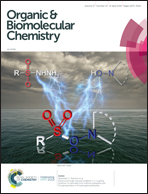Electrochemically induced oxidative S–O coupling: synthesis of sulfonates from sulfonyl hydrazides and N-hydroxyimides or N-hydroxybenzotriazoles†
Abstract
The process of oxidative S–O coupling under the action of electric current was developed. Aryl, hetaryl and alkyl sulfonyl hydrazides and N-hydroxy compounds (N-hydroxyimides and N-hydroxybenzotriazoles) are applied as starting reagents for the preparation of sulfonates. The reaction is carried out under constant current conditions in an experimentally convenient undivided electrochemical cell equipped with a graphite anode and a stainless steel cathode under a high current density (60 mA cm−2). NH4Br in this process acts as a supporting electrolyte and participates in the oxidation of the starting compounds to form a coupling product. The developed strategy represents a quite atom-efficient approach: one partner loses two nitrogen and three hydrogen atoms, while another one loses only one hydrogen atom. Cyclic voltammetry and the control experiment allowed us to propose possible reaction pathways: generated through anodic oxidation molecular bromine or its higher oxidation state derivatives oxidize the starting compounds to form reactive species, which couple to form the S–O bond.



 Please wait while we load your content...
Please wait while we load your content...